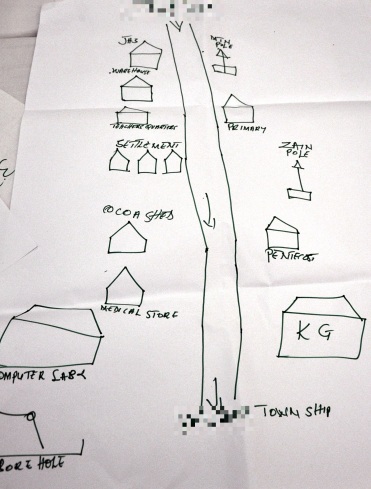Our discussion at the Kwaku (anonymized) community was facilitated by local representatives of an NGO, working towards food security improvements in the Northern Region, through the introduction of soya crops. Farming is the main economic activity in Kwaku. Situated on alluvial soils, the community faces rainy (18-20oC) and the dry (39-40oC) seasons. Vegetation is mostly savannah woodland, with cash crop trees being dawa-dawa, sheanut and mango; and cultivation crops being yam, groundnut, rice.

Records for Kwaku show population of about 3 264 residents, with 48% male and 52% female. The community is characterized by strong traditional governance structures, including the roles of chief warrior, women’s leader, mouthpiece of the chief, chief-in-waiting and youth organizer. Besides chieftancy and the district assembly, formal structures in the community include parent teacher association, traditional birth attendants, youth committee, guinea worm eradication committee, food management committee and women’s groups.

Farmers began the meeting by commenting on new crop varieties and on recent infrastructure developments. The maize variety that was used previously took about 4 to 5 months to mature, but the improved variety which is currently used takes 2 to 3 months to reach maturity. Even though population has been increasing, there is still enough land for farming. In terms of infrastructure, there is no electricity supply but the road to the community was expanded from a narrow foot path to a motorable road in order to aid the transportation of foodstuffs out of the community.
 Mobile phones are recent in the community with Vodafone, MTN and Tigo being the available networks in the area. As objects, mobile phones are carriers of identity and inscribed with value. Out of 16 participants in the discussion, 3 used their phones for text messaging and 5 subscribed to the ‘calling tunes’ value added service. The latter are services which allow subscribers to manage callers’ perceptions by presenting to them selected answer tones. The significance of mobile phones as status symbols and the significance of musical entertainment in the rural context, are demonstrated by the following quote:
Mobile phones are recent in the community with Vodafone, MTN and Tigo being the available networks in the area. As objects, mobile phones are carriers of identity and inscribed with value. Out of 16 participants in the discussion, 3 used their phones for text messaging and 5 subscribed to the ‘calling tunes’ value added service. The latter are services which allow subscribers to manage callers’ perceptions by presenting to them selected answer tones. The significance of mobile phones as status symbols and the significance of musical entertainment in the rural context, are demonstrated by the following quote:
“Some of [us], [we] call it ‘a bar of soap’ because they are big. Those ones, they don’t have camera and they don’t have music player. That’s what we call a ‘bar of soap’. Those ones, [we] don’t like them. […] This one has a torch light on it. A basic one [is] without a torch light. If any of [us] had one with a music payer, and a camera, and those things, you will see which one because [people] will be following him because of the music. […] “
Most people of Kwaku community charge their phone batteries in the nearby district center at a fee of GhC 0.50. The community was once given a solar charger, which ended up bringing a lot of confusion because there were arguments as to who should charge his or her phone first. Consequently, the solar charger was worn out and it is hardly used. Discussing the amounts they spend on call credit per week, 4 people said they spend up to GhC 2 per week. Two people used an average of GhC 3 a week, whereas another 2 used GhC 4-5 a week. One person was spending average of GhC 6-10 per week. Mobile phones are used mostly to complement other information channels, such as social networks. People phone to reach relatives, to access centralized market information services, and to verify the market prices received through such services with their personal contacts. They confirmed that the market information they received was reliable most of the time, and informed their decisions where to sell their produce. On a few occasions, prices were slightly higher or lower than was anticipated through the price information received.
Eight people in the focus group said they have radio sets. They mentioned Radio Savannah, North Star Radio, Radio Justice, Radio Volta and Radio B.A.R as the ones that are transmitted in the area. Radio, they said is mostly listened individually and not in a group; and it is the preferred source of national and international news.Surprisingly, even though people in the Kwaku had no electricity supplu, 3 of the group participants owned TV sets. They bought the television sets when the electric poles were being erected, and they expected that electricity supply will reach them shortly. In terms of legacy technologies, the community has a gong-gong beater who announces meetings. Occasionally, people call each-other on their cell phones to remind of up-coming meetings. Nonetheless, it is considered profligate.






